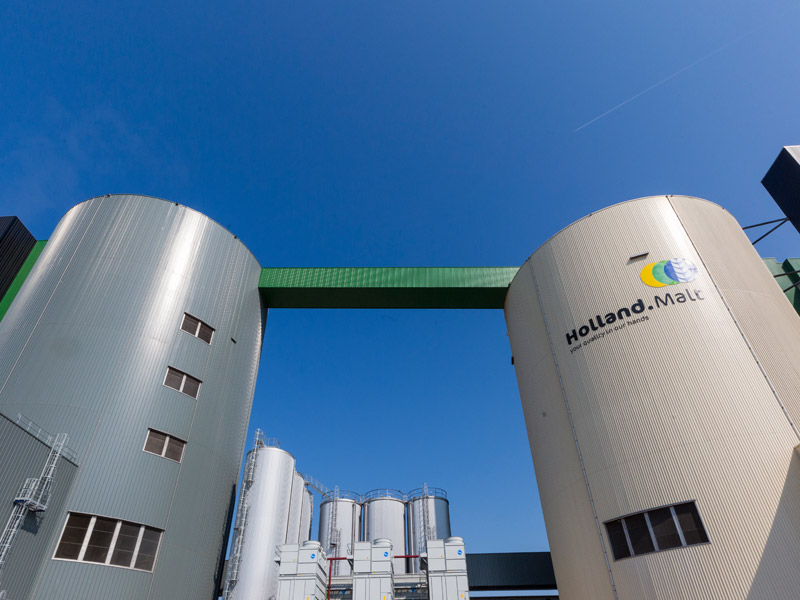Home | Digitalization | Industrial Digitalisations | Data-driven malting helps Holland Malt reduce its ecological footprint
Data-driven malting helps Holland Malt reduce its ecological footprint

IN SHORT
Dit is de kop
Data Science supports technology experts in an objective data-driven quantification on the impacting factors on their production process.
Dit is de kop
Control on the production process enables energy reduction, which reduces costs and also benefits the ecological footprint.
Dit is de kop
Dry runs of the model show very promising results, enabling heat change experiments to accomplish the energy reduction goal.
You can’t brew beer without malt. This key ingredient is made from grain such as barley. When the grain arrives at the malthouse, it first gets cleaned to remove dust and other foreign matter. It’s then covered on and off with water for a day to increase its moisture level to 40-45 percent. This so-called steeping initiates germination in the grain, causing the breakdown of cell walls and the development of enzymes that turn the starch into the sugars needed to form the alcohol. After five days, the resulting green malt is moved to a kiln, where it’s dried to reduce the moisture level to under 5 percent. This effectively halts the germination and prepares the malt for brewing.
“A kiln is a very large oven,” explains Martijn van Iersel, Manager Quality & Technology at the Lieshout-based malthouse Holland Malt. “The green malt is spread out over the floor and large volumes of warm, dry air are blown across by big heaters. As the air passes, it cools off, releasing heat and taking up some of the moist from the grains. For every batch, we have 20-22 hours to complete the drying process and get the malt ready in time for transport to the customer, the brewery.”
One of Holland Malt’s biggest customers is its parent company, Swinkels Family Brewers, co-located in Lieshout and best known for the Bavaria brand. “When you compare all the processes in a malthouse, kilning is the most energy consuming,” says Pieter Meeuws, Business Intelligence & Reporting Analist at Swinkels. “Valuing our commitment to corporate social responsibility and building on our growing data science competency, we decided to see whether we could lower the electricity bill using a data-driven approach. A mere reduction of 1 percent would already save enough energy to power a small village like Lieshout for a year.”
“Valuing our commitment to corporate social responsibility and building on our growing data science competency, we decided to see whether we could lower the electricity bill using a data-driven approach. A mere reduction of 1 percent would already save enough energy to power a small village like Lieshout for a year.”
Pieter Meeuws, business intelligence & reporting-analist bij Swinkels
Turn the dials
Carrying forward their standing relationship, Swinkels turned to the data science consultants from Bright Cape for assistance. “We did a project with them in Ethiopia,” gives Meeuws an example of their earlier collaboration. “After we set up a greenfield brewery there, they helped us run a successful data-driven marketing campaign to best promote our new beer. When we contacted them on behalf of Holland Malt, they supported us again with their data science expertise.” For Bright Cape, located in Amsterdam and Eindhoven, the Holland Malt project aligns nicely with its focal areas. “We develop advanced data science solutions, going from exploration to user experience,” elaborates senior data scientist Daphne van Leeuwen. “We’re mainly active in finance, logistics and manufacturing, with an increasing focus on sustainability.” The project also resonates with the efficiency and sustainability objectives of the High Tech Software Cluster, which brings together Bright Cape and other software specialists to combine, promote and apply Dutch software excellence on a worldwide stage.
Collaborators’ goal was to kiln a batch of malt within the required timeframe of 20-22 hours, delivering the same high quality while using as little energy as possible. “Having varying grain sizes and shapes, different types of barley have different inherent moisture levels and therefore take different times to dry. The conditions outside the oven also play an important role. When the humidity is low, in winter for instance, some batches may already be ready in 15 hours,” describes Van Iersel. “Until recently, we set the heaters to full power, irrespective of the conditions. However, if we were to turn down the heat a little so that the same batch would take 20 hours to dry, we would still be within the set boundaries and we would have used less energy.”
“Holland Malt already had a lot of impact variables readily available, such as the humidity and the temperature in the kiln, the shape and size of the barley and the layer thickness of the green malt,” continues Van Leeuwen. “We processed that data, combined it with external factors like the outdoor humidity and temperature and put everything in a model that, given a set of preconditions, predicts as accurately as possible the time it takes to complete a batch. Holland Malt can use this prediction to turn the oven dials, giving them new data with which they can improve the model and get an even better prediction.”
“We’re seeing some very promising results, confirming that the model can indeed correctly predict the kilning time. We’re nearing the point where, under the right circumstances, we could turn the heat down a notch and actually start saving energy. Currently, we’re still tweaking manually. Ultimately, of course, we’re gunning for a self-correcting model.”
Dry runs
The project started in February of last year and finished this January. Holland Malt is now doing extensive dry runs. Van Iersel: “We’re seeing some very promising results, confirming that the model can indeed correctly predict the kilning time. We’re nearing the point where, under the right circumstances, we could turn the heat down a notch and actually start saving energy. Currently, we’re still tweaking manually. Ultimately, of course, we’re gunning for a self-correcting model.”
“We’re also looking to see if we can optimize multiple kilns at the same time,” adds Meeuws. “Holland Malt has four and we’re exploring if we can cascade them in such a way that we can reuse their residual heat more efficiently. It’s all about how to make the best use of the model, how to benefit best from having a better grip on the process.”
The project has opened Van Iersel’s eyes to the opportunities of data science and modeling: “It’s really remarkable what you can achieve.” For Meeuws, it was a confirmation that you can never have enough data: “Holland Malt already recorded a lot, but the project showed us that we still had some blind spots. So, even if you don’t yet know what you’re going to need it for, collect as much process data as you can.”
TIPS
Dit is de kop
A successful implementation of data science stands or falls with business adoption, therefore, involving technologists and decision-makers from start to end is key.
Dit is de kop
Start small, deliver well – it is important to carefully scope your use case at the start and align extensively with the experts to understand their needs.

Bright cape
Bright Cape makes data accessible for everyone. Not just insight, but a practical solution that immediately adds value. Bright Cape provides the insight and the solution. We always do this together with our client as one team.